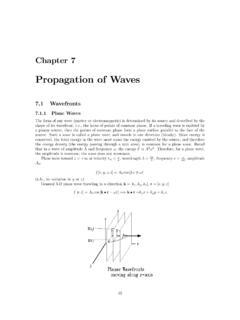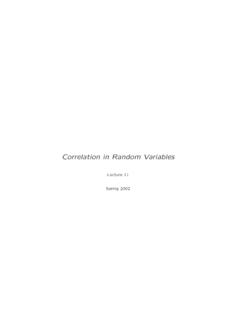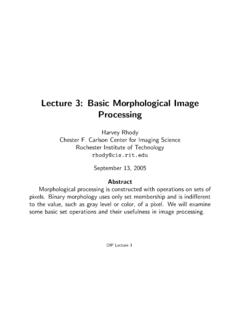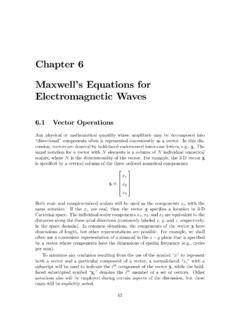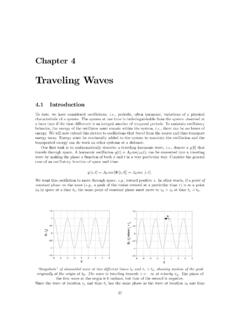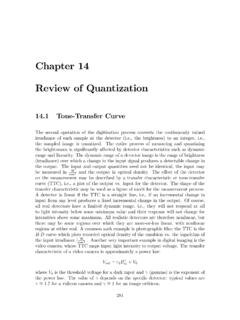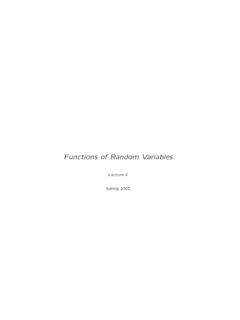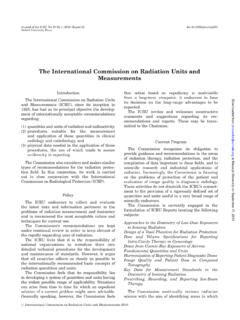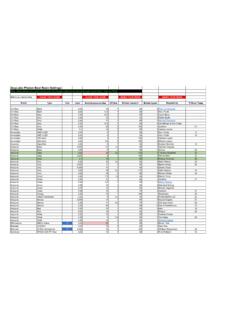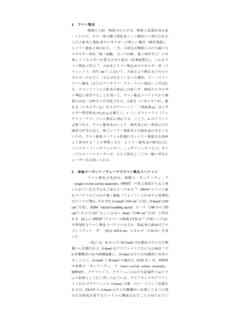Transcription of Poisson and Normal Distributions
1 Poisson and Normal DistributionsLectures 7 Spring 2002 Poisson Distribution The Poisson distribution can be derived as a limiting form ofthe binomial distribution in whichnis increased without limit asthe product =npis kept constant. This corresponds to conducting a very large number of Bernoullitrials with the probabilitypof success on any one trial being verysmall. The Poisson distribution can also be derived directly in a mannerthat shows how it can be used as a model of real situations. Inthis sense, it stands alone and is independent of the binomialdistribution.* Sim eon D. Poisson , (1781-1840).Lecture 71 Conceptual ModelImagine that you are able to observe the arrival of photons at adetector.
2 Your detector is designed to count the number of photonsthat arrive in an interval .The Poisson distribution is based on three basic assumptions, listedon the next generality of the assumptions permits the model to be used inanalyzing many kinds of 72 Poisson Assumptions1. The probability of one photon arriving in is proportional to when is very (1; )=a for small whereais a constant whose value is not yet The probability that more than one photon arrives in is neg-ligible when is very (0; )+P(1; )=1 forsmall 3. the number of photons that arrive in one interval is indepen-dent of the number of photons that arrive in any other non-overlapping 73 Derivation: Step 1 Find the probability that 0 photons arrive in an interval.
3 The probability that a zero photons arrive in is equal to the prob-ability that zero photons arrive in and no photons arrive in .Since the intervals do not overlap, the events are independentandP(0; )=P(0; )P(0; )If we use assumptions 1 and 2 and rearrange we findP(0; ) P(0; ) = aP(0; )Lecture 74 Step 1 (continued)This leads to the differential equationdP(0; )d = aP(0; )The solution isP(0; )=Ce a When we apply the boundary conditionlim 0P(0; )=1wefindC=1,so thatP(0; )=e a Lecture 75 Derivation: Step 2 Consider next the probability thatkphotons arrive in interval + .There are only two in and 0 arrive in 1 arrive in and 1 arrives in.
4 Since these events are mutually exclusive,P(k; + )=P(k; )P(0; )+P(k 1; )P(1; )Now substitute forP(0; )andP(1; ) and (k; + ) P(k; ) +aP(k; )=aP(k 1; )Lecture 76 Step 2 (continued)In the limit we have the differential equationdP(k; )d +aP(k; )=aP(k 1; )This is a recursive equation that tiesP(k; )toP(k 1; ).To solveit we need to convert it into something we can integrate. Multiplythrough byea :ea dP(k; )d +aea P(k; )=aea P(k 1; )The term on the left can be expressed as a total derivativedd (ea P(k; ))=aea P(k 1; )Lecture 77 Step 2 (continued)dd (ea P(k; ))=aea P(k 1; )Integrate with respect to ea P(k; )= 0aeatP(k 1;t)dt+CNote thatP(k; 0) = 0 so that the constant of integration isC= (k; )=ae a 0eatP(k 1;t)dtLecture 78 Derivation: Step 3 Apply a recursion starting withk= 1 to obtainP(1; ).
5 P(1; )=ae a 0eatP(0;t)dt=ae a 0eate atdt=ae a 0dt=a e a Then do the recursion again to obtainP(2; ),and so conclude that the Poisson distribution can be expressedasP(k; )=(a )ke a k!Lecture 79 Expected Value ofkThe expected number of photons in can be obtained by findingthe first [k]= k=0k(a )ke a k!=a If corresponds to time in seconds thenacorresponds to the averagerate of photon arrival in photons per quantitya corresponds to the parameter =npof the 710 Average Number of EventsThe expected number of photons in thenintervals isnp= =a .Hence, =a .When the rateais given and the interval is fixed, it is common towrite the Poisson distribution asP(k; )=( )ke k!
6 Lecture 711CF of Poisson DistributionThe characteristic function isM(iu)=E[eiu]= k=0P[k, ]eiuk= k=0 ke k!eiuk=e k=0( eiu)kk!=e (eiu 1)Lecture 712 Variance of the Poisson Distributionvar(k)=E[k2] E2[k]=a The calculation is left as an that the mean and the variance of a Poisson distribution areequal to each 713 Normal DistributionThe function defined byg(x)=1 2 e 12x2is called the Normal probability density Normal probability distribution function isQ(x)=1 2 x e 12t2dtLecture 714 Error FunctionThe distribution function is often presented in a slightly differentform This form, which is called the error function iserf(z)=2 z0e u2duThis form of the error function is built into the IDL language as thefunction ERRORF.
7 In the exercises you are asked to show that thedistribuition function and the error function are related byQ(x)=12+12erf(x 2)Lecture 715 Relationship to the Binomial DistributionLetSnbe the number of successes innBernoulli trials. The prob-ability that the number of successes is between two values,aandb,P[a Sn b]=b r=ab[n, r, p]The following theorem states that this probability can be computedby use of the Normal distribution.(DeMoivre-Laplace limit theorem)Letm=npand = np(1 p).For fixed values of parametersz1andz2,asn ,P[m+z1 Sn m+z2 ] Q(z2) Q(z1)Lecture 716Z-ScoreThe parametersz1andz2are distances from the mean measured inunits of.
8 If we define a normalized random variableZn=Sn np np(1 p)we have the equivalent probability relationshipP[z1 Zn z2] Q(z2) Q(z1)In terms of the error function isP[z1 Zn z2] 12erf(z2 2) 12erf(z2 2)Lecture 717 Comparison of DistributionsA comparison of the binomial, Poisson and Normal probability func-tions forn= 1000 andp= , , The Normal and Poissonfunctions agree well for all of the values ofp,and agree with thebinomial function forp= 718
